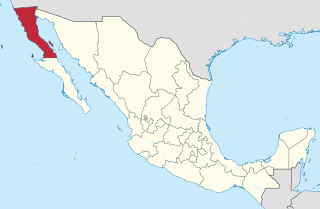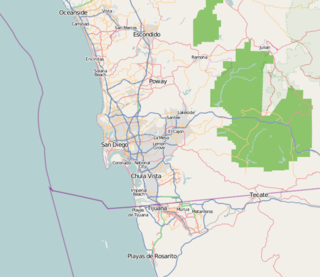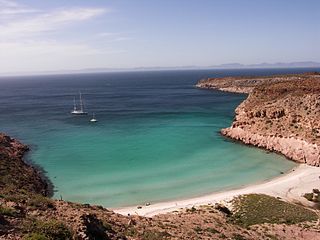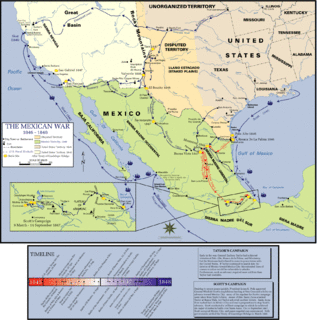Related Research Articles

The Baja California Peninsula is a peninsula in Northwestern Mexico. It separates the Pacific Ocean from the Gulf of California. The peninsula extends 1,247 km from Mexicali, Baja California in the north to Cabo San Lucas, Baja California Sur in the south. It ranges from 40 km at its narrowest to 320 km at its widest point and has approximately 3,000 km of coastline and approximately 65 islands. The total area of the Baja California Peninsula is 143,390 km2 (55,360 sq mi), roughly the same area as the country of Nepal.

Baja California, officially the Free and Sovereign State of Baja California is a state in Mexico. It is the northernmost and westernmost of the 32 federal entities of Mexico. Before becoming a state in 1952, the area was known as the North Territory of Baja California. It has an area of 70,113 km2 (27,071 sq mi) and comprises the northern half of the Baja California Peninsula, north of the 28th parallel, plus oceanic Guadalupe Island. The mainland portion of the state is bordered on the west by the Pacific Ocean; on the east by Sonora, the U.S. state of Arizona, and the Gulf of California; on the north by the U.S. state of California; and on the south by Baja California Sur.

Baja California Sur, officially the Free and Sovereign State of Baja California Sur, is the second-smallest Mexican state by population and the 31st admitted state of the 32 states which make up the 32 Federal Entities of Mexico. It is also the ninth-largest Mexican state in terms of area.

Bahía de los Ángeles is a coastal bay on the Gulf of California, located along the eastern shore of the Baja California Peninsula in the state of Baja California, Mexico. The town of the same name is located at the east end of Federal Highway 12 about 42 miles (68 km) from the Parador Punta Prieta junction on Federal Highway 1. The area is part of the San Quintín Municipality.

La Paz is the capital city of the Mexican state of Baja California Sur and an important regional commercial center. The city had a 2020 census population of 250,141 inhabitants, making it the most populous city in the state. Its metropolitan population is somewhat larger because of the surrounding towns, such as El Centenario, Chametla and San Pedro. It is in La Paz Municipality, which is the fourth-largest municipality in Mexico in geographical size and reported a population of 292,241 inhabitants on a land area of 20,275 km2 (7,828 sq mi). The population of La Paz has grown greatly since the 2000s.

Francisco de Ulloa was a Spanish explorer who explored the west coast of present-day Mexico and the Baja California Peninsula under the commission of Hernán Cortés. Ulloa's voyage was among the first to disprove the cartographic misconception of the existence of the Island of California.

Ensenada is a coastal city in Mexico, the third-largest in Baja California. Lying 125 kilometres (78 mi) south of San Diego on the Baja California Peninsula, it is locally referred to as La Cenicienta del Pacífico, "The Cinderella of the Pacific".

Sebastián Vizcaíno (1548–1624) was a Spanish soldier, entrepreneur, explorer, and diplomat whose varied roles took him to New Spain, the Philippines, the Baja California peninsula, the California coast and Japan.

San Felipe is a town on the bay of San Felipe in the Gulf of California in the Mexican state of Baja California, 190 km south of the United States border and within the municipality of Mexicali. The population of San Felipe was 17,708 at the 2015 census, and can increase by up to 5,000 due to the presence of Canadian and U.S. part-time residents, who travel to the town from the United States during the American holidays Spring Break and Memorial Day. It also serves as a borough seat of its surrounding area.

The Coronado Islands are a group of four islands off the northwest coast of the Mexican state of Baja California. Battered by the wind and waves, they are largely barren and uninhabited except for a small military detachment and a few lighthouse keepers. The islands lie between 15 and 19 miles south of the entrance to San Diego bay, but only 8 miles from the Mexican mainland. They share their name with the island city of Coronado, California, which separates San Diego Bay from the Pacific Ocean, on the other side of the United States-Mexico border.Coronado is a peninsula not an island. It is accessed by the Coronado bridge the north side and accessible by land no bridge from the south on 75 south and Coronado bay road along Silver strand beach.

Federal Highway 1 is a free (libre) part of the federal highway corridors of Mexico, and the highway follows the length of the Baja California Peninsula from Tijuana, Baja California, in the north to Cabo San Lucas, Baja California Sur, in the south. The road connects with Via Rapida, which merges into the American Interstate 5 (I-5) at the San Ysidro Port of Entry, which crosses the international border south of San Ysidro, California.
San Antonio is a small town in La Paz Municipality in the Mexican state of Baja California Sur, located near El Triunfo on Federal Highway 1. It had a population of 463 inhabitants in the 2010 census, and is situated 400 meters (1,312 ft.) above sea level.

The Spanish missions in Baja California were a large number of religious outposts established by Catholic religious orders, the Jesuits, the Franciscans and the Dominicans, between 1683 and 1834 to spread the Christian doctrine among the Native Americans or Indians living on the Baja California peninsula. The missions gave Spain a valuable toehold in the frontier land, and introduced European livestock, fruits, vegetables, and industry into the region. The Indians were severely impacted by the introduction of European diseases such as smallpox and measles and by 1800 their numbers were a fraction of what they had been before the arrival of the Spanish.

San Diego–Tijuana is an international transborder agglomeration, straddling the border of the adjacent North American coastal cities of San Diego, California, United States and Tijuana, Baja California, Mexico. The 2012 population of the region was 4,922,723, making it the largest bi-national conurbation shared between the United States and Mexico, the second-largest shared between the US and another country. In its entirety, the region consists of San Diego County in the United States and the municipalities of Tijuana, Rosarito Beach, and Tecate in Mexico. It is the third most populous region in the California–Baja California region, smaller only than the metropolitan areas of Greater Los Angeles and the San Francisco Bay Area.

Isla Partida is separated from Isla Espíritu Santo by a shallow, narrow channel. These two islands, in the Gulf of California, are protected by UNESCO as biospheres. They are located a short boat ride from La Paz, which lies on the Baja California Peninsula in Mexico. It has a land area of 15.495 km (9.628 mi) and is part of the Municipality of La Paz in Baja California Sur.

Isla San José is a semi-arid island in the Gulf of California, off the east coast of the Baja California peninsula. Located some 60 km (37 mi) north of the city of La Paz, it belongs politically to the Mexican state of Baja California Sur and is part of the Municipality of La Paz. Its surface area is 182.962 km2, the sixth-largest island in Mexico. The island is also referred to as San José Island in English, though there are other islands by this name.

The Pacific Coast Campaign refers to United States naval operations against targets along Mexico's Pacific Coast during the Mexican–American War. It excludes engagements of the California Campaign in areas of The Californias north of the Baja California Peninsula. The objective of the campaign was to secure the Baja Peninsula of Mexico, and to blockade/capture west-coast ports of Mexico—especially Mazatlan, a major port-of-entry for imported supplies. The resistance of Mexican forces to the north in the Los Angeles area and the lack of ships, soldiers and logistical support prevented an early occupation of the peninsula and the west-coast Mexican seaports. The U.S. Navy attempted blockades of the ports three times before being able to successfully blockade and/or occupy them.
Skirmish of Todos Santos, was the last clash of the Mexican–American War and ended eighteen months of hostilities in Baja California.
Manuel Pineda Munoz (1804–1891), Mexican Army officer that led the Mexican resistance to the forces of the United States in Baja California Sur, during the Mexican–American War. Victor of the Battle of Mulege, he inspired the resistance force of bajacalifornios to attack and then besiege La Paz and attack San José del Cabo. Although he was eventually defeated and later captured at San Antonio de la Sierra, the protracted resistance he led made the American hold on the Baja California peninsula unsecure and prompted American statesman to omit in the final peace treaty, their original demand for the annexation of Baja California and Baja California Sur.
Francisco Palacios Miranda was the Governor and Military Commandant of the Baja California Territory from 1844 to 1847. He is known for his cooperation with the Americans during the Mexican American War, accepting neutrality of his Territory in 1846 and making the abject surrender of La Paz to the Americans in 1847. For this he was declared a traitor and forced into exile at the end of the war.
References
- ↑ Richard W. Amero, The Mexican-American War in Baja California, The Journal of San Diego History, SAN DIEGO HISTORICAL SOCIETY QUARTERLY, Winter 1984, Volume 30, Number 1.
Coordinates: 24°16′34″N110°19′40″W / 24.27611°N 110.32778°W
